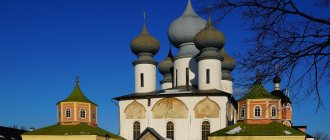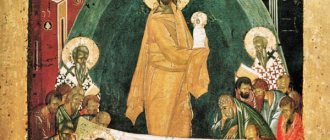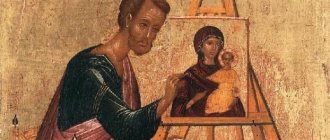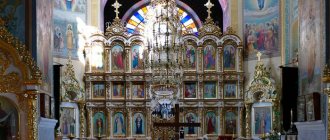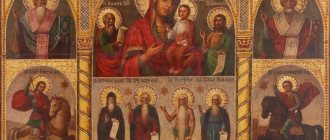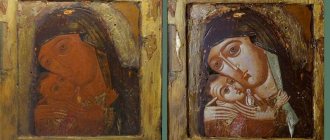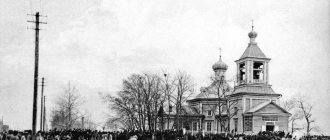The miraculous Blachernae Icon of the Mother of God is considered one of the rarest images of the Mother of God. She was brought to Constantinople in 439, and especially for her, by order of Emperor Leo the Great, a church was erected in the western part of the city, nicknamed Blachernae (the Scythian leader Blakherna was once killed there). According to legend, it was at that place that the Mother of God appeared to Andrei the Holy Fool.
Date of celebration: July 20
The icon received the name of the Blachernae Mother of God, and although after the fire of 1434, when the church was destroyed by fire, the icon was moved to another church, its name was retained.
Description of the icon
The dimensions of the icon are relatively small: 46 × 37.5 × 4 cm. According to the type of icon painting, it is Hodegetria, which translated from Greek means Showing the Path, or Guide. The technique in which it is made is unusual: it is wax mastic, which allows you to obtain a relief image. Thanks to this, the image seems to protrude above the board, making a stunning impression on believers and inspiring awe.
What makes the Blachernae icon even more valuable is the fact that wax and the relics of Christian martyrs mixed with it were used to create it, that is, it is not just an icon, but a reliquary.
The Blachernae image differs from other iconographic images of the Mother of God in the pronounced massiveness of the figure, as well as wider halos. In pictorial copies (lists), icon painters tried to give the images of the Virgin and Child the same relief.
LiveInternetLiveInternet
Hodegetria (Greek Οδηγήτρια - Showing the Way), Guide - one of the most common types of images of the Mother of God with the baby Jesus. The Child-Christ sits in the arms of the Mother of God, with his right hand he blesses, and with his left he holds a scroll, less often a book, which corresponds to the iconographic type of Christ Pantocrator (Almighty). As a rule, the Mother of God is represented in a half-length image, but abbreviated shoulder-length versions (Kazanskaya) or full-length images are also known. This type of Mother of God icons became unusually widespread throughout the Christian world, and especially in Byzantium and Russia. The Blachernae icon is a rare example of relief icons.In sources of the 17th century and in literature of the 18th-19th centuries it is called mastic-wax.
Its basis is a flat relief carved in wood, covered with a layer of wax-mastic and painted with paints. The painting technique is distinguished by great skill. Even during the stay of the Blachernae Icon in Constantinople, Patriarch Paisius of Constantinople drew up a Certificate of Attestation, which noted one of the most important features of the Blachernae Icon: it was made “by a mixture of holy relics and many other fragrant compositions,” i.e. it is a reliquary reliquary. In the literature of the 19th century there is a mention of the composition of the relics - these are the ashes of the holy martyrs of Nicomedia (Victor, Victorinus, Claudian, Vassa), Sinai and Raifa. The history of the construction of the Blachernae Temple is interesting.
***
Blachernae Temple
The very name of the area in the western part of Constantinople - Blachernae - speaks volumes to the Orthodox heart.
Here, on the site of the murder of the Scythian leader Vlah, in the 5th century, under Emperor Leo the Great, a church was built in the name of the Most Pure One. It was in it that the famous vision of the Mother of God to Andrei the Holy Fool took place, which we celebrate as one of the most beloved holidays in Rus' - Intercession. In the middle of the fifth century, during the reign of the Byzantine emperor Leo I Makela, two of his close associates Galbi and Candide went on a pilgrimage to the Holy Land. In a village not far from Nazareth, they decided to spend the night in the house of a pious woman. Their attention was attracted by burning candles and smoking incense. When asked what kind of shrine was kept in the house, the hostess did not want to answer for a long time. When, after persistent requests from the guests, she finally gave in, it turned out that it was the Robe of the Mother of God. Just before her Assumption, the Virgin Mary gave it to one pious widow, bequeathing it to be passed on by inheritance. Galbius and Candide were able to convince the woman of the need to take the shrine to the capital of the empire. In Constantinople, for this occasion, they decided to erect a separate temple around the miraculous spring in Blachernae, a picturesque place on the coast of the Golden Horn Bay, where the Vlachs, that is, Romanians and Western Slavs, had long lived. In 474, the honorable vestments of the Mother of God, brought from Palestine, were placed in this church; The memory of this event is celebrated by the church on July 2 - the patronal feast of the Deposition of Churches. This temple burned down in 1434. ***
But there was also another temple of the Mother of God in Blachernae, where there was an icon of the Ever-Virgin, which accompanied many Byzantine emperors on their military campaigns. In 435, the Byzantine empress Augusta Pulcheria erected a church. Emperor Justinian added two arches to it, and the temple took the shape of a cross. They always took this shrine with them as their main protector, so that “the Orthodox army felt under the protection of the Mother of God.”
This icon, called Blachernae, by the providence of God passed from the Second Rome to the Third and has remained unharmed to this day. According to legend, the very first Hodegetria (Blachernae icon) was performed by the Evangelist Luke. ***
Historical path of the Icon
Initially famous for many miracles, the image stayed in Antioch, then in Jerusalem.
The wife of the Byzantine Emperor Theodosius II (408 - 450) Eudokia, who traveled to Jerusalem to worship holy places in 436 -437, acquired the icon and sent it to Constantinople as a gift to the emperor’s sister, St. Pulcheria. The icon was placed by Pulcheria in the temple located in Blachernae, and since then the shrine has been named after Blachernae. The above-mentioned Certificate of Attestation from Patriarch Paisius was subsequently sent to Rus', together with a message from Protosyncellus Gabriel, apparently in response to the king’s request. In these documents, the icon is identified with one of the ancient shrines of the Blachernae Temple. According to the charter, during the time of Emperor Heraclius, the icon of the Mother of God “Hodegetria” saved Constantinople from the invasion of the Persians and Avars (626), and many miracles also occurred in the monastery of the Mother of God in Blachernae. After the capture of Constantinople by the Turks (1453), the Blachernae icon was transferred to the Monastery of Christ. Before the monastery church was turned into a mosque, pious people hid the Blachernae icon in a window niche and walled it up. Later, the icon was miraculously found, and the servant of the mosque, having removed the precious frame, sold the icon to a certain widow, who brought it as a gift to the protosyncellus (abbot) of the Jerusalem courtyard in Constantinople, Gabriel. According to information from the 17th century, the Miraculous Icon was sent to Moscow from Constantinople as a gift to Tsar Alexei Mikhailovich from the protosyncellus Gabriel. The solemn meeting of the icon took place on October 16, 1653 (7162). The attitude towards the Blachernae icon as the patroness of Constantinople and the Greek emperors immediately placed it among the most important shrines of the Russian state. It was decorated with a precious frame, placed on the altar of the Kremlin Assumption Cathedral and took its place in church ceremonies and the everyday life of the royal court, as evidenced by cathedral officials and historical sources. The most important episode in the legend about the icon is the story about its miraculous help in saving Constantinople from an enemy siege. In memory of this event, under Patriarch Nikon in the Assumption Cathedral, it became customary annually on the 5th Saturday of Great Lent, during the reading of the Akathist to the Most Holy Theotokos, the 1st kontakion of which glorifies this miracle, to place the Blachernae icon on a lectern in the center of the temple. On the New Year's Day (September 1), this image also occupied one of the central places - on the analogue, opposite the Vladimir Icon of the Mother of God - as a symbol of the protection that the shrine of the Byzantine Empire was now supposed to provide to the Tsar of Moscow and the entire Russian state. In this capacity, the Blachernae icon accompanied the tsar on the Smolensk campaigns (1654-1655), according to the testimony of Pavel of Aleppo, who left the first description of the monument brought to Rus'. In 1674, by order of Tsar Alexei Mikhailovich, it was repaired by icon painters of the Armory Chamber Simon Ushakov and Nikita Pavlovets, who, in particular, strengthened it with a new cypress board. In 1812, during Napoleon's invasion, the image remained in the cathedral. After the enemy was expelled, the icon was found damaged. In 1813, the icon was renewed after the Napoleonic invasion: it was duplicated on a new cypress board and decorated with a silver chasuble. During this period, new inscriptions were made on it in Greek: “Lady of the Blachernae Monastery” and “Valuable Treasure,” and on the lower field there was an inscription in Russian about the renovation with the date August 1, 1813. In 1918, in connection with the closure of the Assumption Cathedral by the Soviet authorities, part of its shrines, including the Blachernae Icon, was transferred to the Church of the Exaltation of the Cross, located not far from the Kremlin. In 1931, when this temple was destroyed, the shrines returned to the Kremlin, becoming part of the museum collection of the GMMC. … *** In 1983, the icon was restored at the All-Russian Artistic Research Center by L. A. Dunaev: layers of late writing were removed from the margins and background of the icon; on the figures, due to the fragmentary preservation of the author’s layer of copywriting, they were left, with the exception of a small sample on the left shoulder of the Infant .
Fragments of the original painting have been preserved in images of the left eye of the Mother of God and the hand of the Child holding a scroll. Currently, the Blachernae icon is in the Assumption Cathedral of the Moscow Kremlin. There are three known lists of the icon, made at different times: 1. Belonging to the Stroganov family, and from the mid-18th century to the Golitsyn family. The icon was kept on an estate in the village of Blachernae (Kuzminki) near Moscow, where a church was built, consecrated in honor of the Blachernae icon. Currently this list is kept in the Tretyakov Gallery. 2. From the Church of St. Sergius of Radonezh in the Moscow Vysoko-Petrovsky Monastery (established in 1701), currently kept in the Church of the Nativity of the Virgin Mary in Stary Simonovo). 3. From the Spaso-Vlaherna Monastery near the city of Dmitrov (one of the shrines of the Golovin family, created in 1705, currently located in the Andrei Rublev Museum).
The second and third lists are exact copies of the Kremlin icon; they had similar precious frames with an inscription about the salvation of the icon of Constantinople from enemies through the intercession. In imitation of the original, these two lists are made as reliquary icons - the crowns are “filled with many particles of the holy relics of various saints of God.” In the descriptions, these icons are called wax-mastic, but in fact they are relief wooden images, covered with gesso and painted with tempera, that is, they differ from the Byzantine prototype. Temples in honor of the Blachernae Icon 1. In Kuzminki
2. At the end of the 10th century, the Abkhazian king Bagrat II (later who became the king of Georgia under the name Bagrat III) built the Bedia Cathedral in honor of the Blachernae Icon of the Mother of God, in which the king himself was later buried.
3. In 1825-1830, in the Georgian city of Zugdidi, the Blachernae Church was built in which a copy of the icon, revered in Georgia, was placed. Funds for construction were allocated by Emperor Alexander I, to whom this list was sent as a gift by the Mingrelian princess Nino.
Sources: Wikipedia, https://fotki.yandex.ru/users/kondoribbrat/, etc.
From the history of the Blachernae icon
The Blachernae icon has long been considered the patroness of both Constantinople itself and the Byzantine emperors. When the city was besieged by enemies in 626, Patriarch Sergius walked around its walls with an icon in his hands, and the Mother of God herself, according to their own statement, appeared to the enemies, after which they retreated in fear.
Another miracle associated with the Blachernae icon occurred during the era of iconoclasm. Then the icon, together with the lamp burning in front of it, was walled up in the wall of the Pantocrator Monastery, where it was discovered a hundred years later, and the lamp continued to burn.
It was this icon that was delivered to Rus' in 1653 as a gift to Tsar Alexei Mikhailovich, accompanied by a certificate of its origin and veneration. Here the icon was immediately revered as one of the greatest shrines, decorated with a frame of chased gold with a large number of precious stones and pearls, and gold plates were attached, where its legend was set out.
The Blachernae icon was kept in the Assumption Cathedral of the Moscow Kremlin, from where the tsar always took it with him on military campaigns. Currently it is in the Tretyakov Gallery, and its relief copy, granted to the father of Grigory Stroganov and dating from the 17th or 18th century, is in the Blachernae Church in Kuzminki, which was built especially for it. It became a family shrine of the Stroganov family.
History of the icon
The miraculous icon of the Mother of God of Blachernae appeared in Antioch with the name “Hodegetria”. In 437 imp. Evdokia was transferred to Jerusalem, and from there to Constantinople, where the emperor’s sister St. Pulcheria placed it in the Blachernae Church.
During the siege of Constantinople by the Persians and Avars, Patriarch Sergius walked around the walls of the Byzantine capital with the icon of the Blachernae Mother of God. At the sight of the image of the Most Holy Mother of God, the enemies retreated.
The image of the Most Holy Theotokos more than once protected the inhabitants of Constantinople from raids and gave soldiers the strength to defend the borders of the holy city.
In the 8th century, when the iconoclastic heresy arose in Constantinople, some pious men took the venerable icon of the Mother of God “Hodegetria” from the Blachernae church at night and took it to the monastery of Pantocrator. There they hid her in the church wall and, lighting a lamp in front of her, covered her with stones.
The icon was kept in such secrecy for about a hundred years, until the death of the last heresy leaders. When the veneration of icons was restored in the Greek empire, the zealots of Orthodoxy, by the revelation of God, found a miraculous icon in the wall of the Church of Pantocrator and a burning lamp in front of it. With great triumph they placed it in its original place in the Blachernae church.
It was this icon that was delivered to Rus' in 1653 as a gift to Tsar Alexei Mikhailovich, accompanied by a certificate of its origin and veneration. Here the icon was immediately revered as one of the greatest shrines, decorated with a frame of chased gold with a large number of precious stones and pearls, and gold plates were attached, where its legend was set out.
After the capture of Constantinople by the Turks, “Hodegetria” was hidden for some time in the Patriarchate, from where, for greater safety, it was sent to Athos, and on October 17, 1654 - to Moscow to Tsar Alexei Mikhailovich. Patriarch Nikon met her at the Execution Ground.
In 1812, after the expulsion of enemies from Moscow, this icon was found somewhat damaged and without the board in which it was inserted. Now it is cut into a new cypress board and decorated with a silver chasuble.
The Blachernae icon is made of wax mastic. Casts were made of this icon in Russia, which were located: one in the Moscow VysokoPetrovsky Monastery, the other in the village of Kuzminki, Prince. Golitsyn, and the third in the village of Dedenev, near Dmitrov, in the Spaso-Vlaherna Monastery. And these icons, in turn, became famous for many blessed phenomena.
The Blachernae temple was located in a small suburb in the northwest of Constantinople. The icon of the Mother of God later received its name from the name of the temple.
Prayer before the icon
Blessings to my queen, my hope to the Mother of God, friend of the orphans and strange intercessors, those who grieve with joy, those who are offended by the patroness! See my misfortune, see my sorrow, help me as I am weak, feed me as I am strange. Weigh my offense, resolve it as if by will: for I have no other help except You, no other intercessor, no good comforter, except You, O Mother of God, for you will preserve me and cover me forever and ever. Amen.
( 3 ratings, average: 5.00 out of 5)
Prayers
Troparion
(during Akathist, voice not specified)
Many-valued treasure, Mother of God, / your many-wonderful image of the holy Blachernae, / you deigned to reveal in Jerusalem to the earth, / later throughout the Christian world you glorified its miracles. / And Now we come running to You and ask You: Heal our weak souls from sin, / and in all matters help us, / we may be resurrected through repentance, / so that we may be able to glorify the Lord together with you forever in Heavenly Jerusalem.
It all started with Russian robbers
As Church Tradition says, one day the holy fool Andrew (a Slav by birth, who was a slave of a Byzantine nobleman) and his friend Epiphanius prayed side by side for several hours in the Blachernae Church of Constantinople and suddenly St. Andrew saw the Most Holy Theotokos.
The Mother of God walked from the western doors of the temple, accompanied by Saints John the Baptist and John the Theologian.
Both Andrei and Epiphanius saw the Mother of God kneeling and praying with tears for the people. Then she entered the altar, prayed again and, taking off the omophorion (large veil) covering Her head, spread it over the people kneeling before Her.
Our correspondent visited Vlaherna (a district of Istanbul) - at the very place where the appearance of the Intercession of the Mother of God took place, which served as the beginning of the events described.
Then there stood the Blachernae Church, in which the famous Blachernae icon of the Most Holy Theotokos (according to legend, painted by the Apostle Luke) was located. And next to the temple is the holy spring of the Mother of God, which has survived to this day.
The life of Blessed Andrew does not say when the miraculous appearance of the Intercession of the Virgin Mary took place. But a later legend connects it with the campaign of Russian princes against Byzantium. Then the Intercession of the Mother of God protected Constantinople from the attack of the Slav squad.
Their ships were scattered by a sudden storm, and the city was saved. The same “prophetic Oleg” took part in this campaign, who later nailed the “shield to the gates of Constantinople.”
After the unsuccessful raid, Rus' was baptized, and the Protection of the Most Holy Theotokos - her protection from robbers - began to be especially remembered in Rus'.
Only the veneration of the Most Holy Theotokos as a protector from robbers has grown in us into veneration of the Mother of God as an intercessor for the robbers and prisoners themselves - traditionally prison churches in Russia are consecrated in honor of this holiday.
